August 19, 2019
Using Ornamental Grasses in the Landscape
Twenty-five years ago, ornamental grasses were rarely seen in the landscape. As their virtues – low maintenance, drought tolerance, a long season of interest – became more widely known, gardeners began to integrate them into their landscapes. Today they are recognized for bringing qualities of light, line, motion and sound to the garden. They are durable, graceful and versatile. No matter the size or variety, ornamental grass foliage has a unique architectural quality. Strongly linear, yet at the same time pliant and sinuous, grasses add a wonderful sense of motion to the garden. They sway in even the slightest breeze and add a sense of drama in heavy winds. There is a special luminous quality to the foliage and inflorescences (ie. flowers) when the low angle of the autumn and winter sun shines through from behind. Whether you garden in a container, have a small urban lot, a sizeable suburban yard, or a country property, ornamental grasses can help define your space. They can be used as groundcover, as edging along a pathway, as a privacy screen, and as part of mixed perennial and shrub borders. Some are low and clumping, some are arching, and others are more upright. While some bloom in spring, others start blooming in August, and their plumes subtly change color as they age. Grasses can be left in place all winter. Their straw-like colors and interesting textures are attractive to look at and provide food and shelter for birds.
Grasses respond and start to grow based upon temperature. Some grasses will start to grow in early spring when temperatures are still cool and others will wait until the soil is warm and temperatures are more stable. Cool season grass will start to grow early in the spring and may even remain semi- evergreen over the winter. Warm season grasses do not begin to show growth until the weather becomes stable and the soils warm. The previous season’s growth of warm season grasses requires cutting back to 4-6” in the spring. Here are some top performing ornamental grasses in the New England area:
Calamagrostis (Feather Reed Grass)
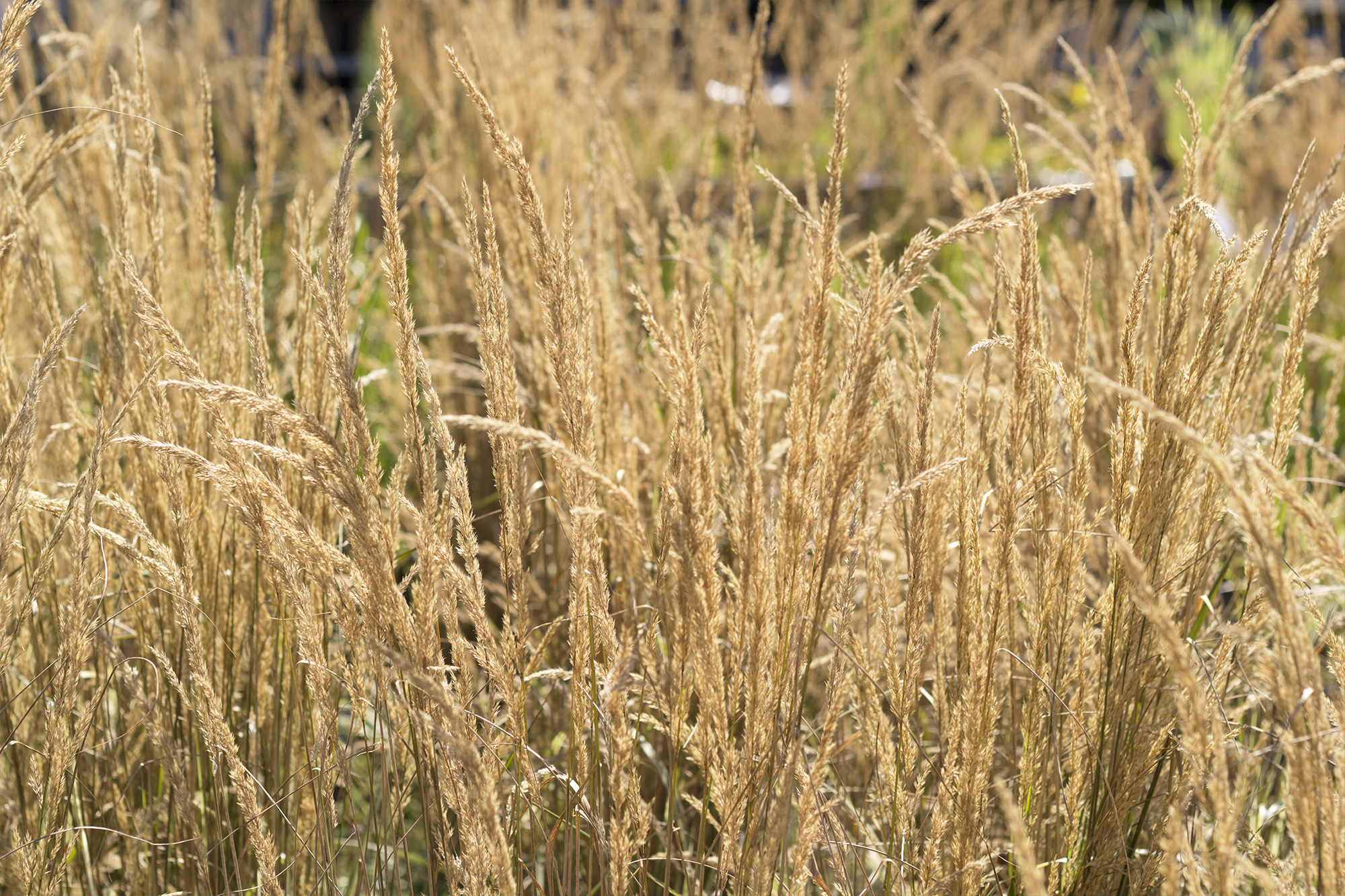
^ Calamagrostis x acutiflora ‘Overdam’ has creamy white and green stripes along the length of its leaves. The foliage grows to 18” but its seed heads reach a majestic 5-6’.
Calamagrostis x acutiflora ‘Eldorado’ has distinctive golden and green variegated foliage that grows in a neat clump and reaches a height of 3-5’. The stems have an attractive honey-colored hue. Plumes appear in summer and add a vertical element to a height of 6’. Calamagrostis x acutiflora ‘Karl Foerster’ was named Perennial Plant of the Year is 2001, the first ornamental grass to be so honored. The green foliage grows in a neat, upright 2’ clump. In early spring, stalks rise to 6’, capped with elongated wheat-colored seed heads. It is undemanding and will tolerate clay and compacted soil conditions. Good looks, long-lasting plumes and undemanding growing requirements – no wonder it is an award winner!
Carex
Many varieties of Carex make effective ground covers. They also sparkle in containers and mixed plantings. While most ornamental grasses prefer sunny conditions, Carex thrives in shade. It flowers in late spring.
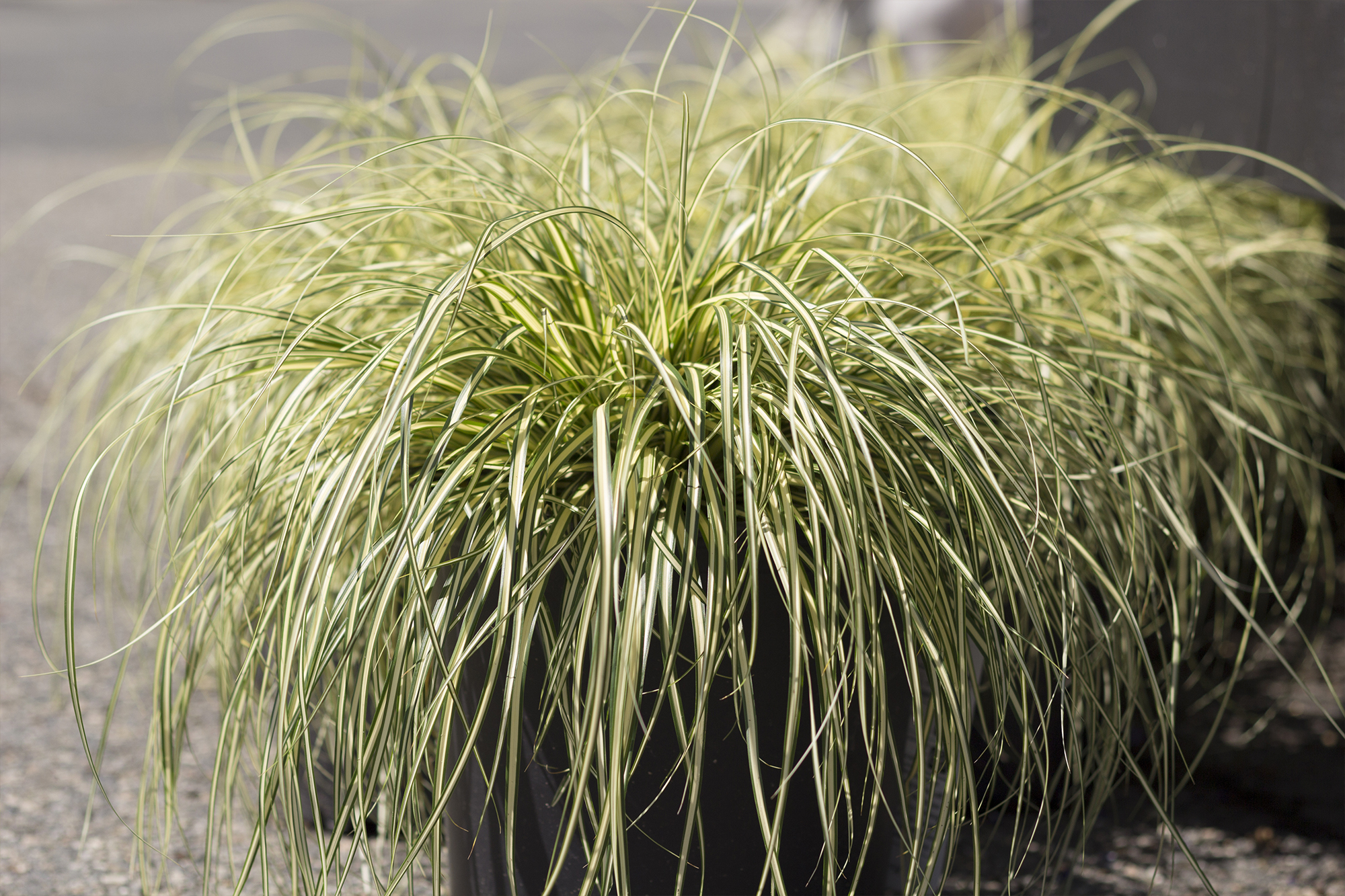
^ Carex oshimensis ‘Evergold’ has fine blades with narrow green margins and a broad yellow center.
Carex morrowii ‘Ice Dance’ grows to a height of 12” in a gently arching form. Its narrow blades are deep- green and have a white striped edge that will brighten a shady area. It spreads slowly via rhizomes.
Carex morrowii ‘Ice Ballet’ is a sport of ‘Ice Dance’ and has wider, creamy-white margins on the blade.
Festuca

^ Festuca glauca ‘Elijah Blue’ has gorgeous blue foliage that grows in a tight clump. It maintains its color throughout winter. It forms spiky mounds that are 10” in height. It thrives in sunny situations and flowers in early summer. It makes a lovely edging along a stone pathway and brings a beautiful blue tone to the garden when planted in groups in the perennial border. Prune any winter damaged foliage, but otherwise do not cut back.
Hakonechloa (Hakone Grass)
Hakonechloa adds interesting form and texture to the garden with its graceful, arching habit. It tolerates sun but prefers a shady location to keep its tips from scorching. It is semi-evergreen and will only require cutting back any winter damaged or spent blades. With age, it develops an interesting mounding and cascading shape that seems to flow like a waterfall. It is magical when it sways and rustles in the wind. All in all, a beautiful, elegant grass for the garden.
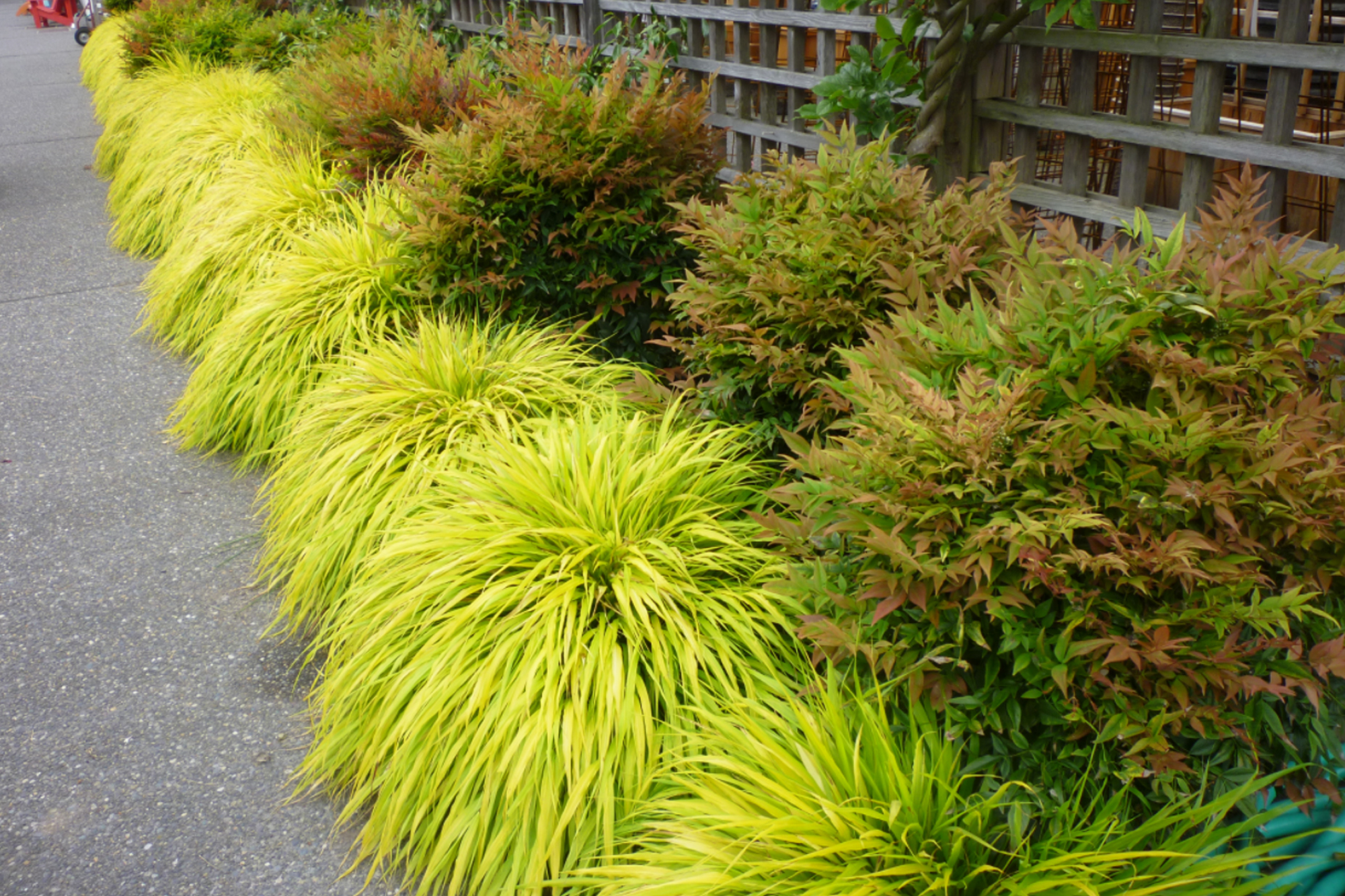
^ Hakonechloa macra ‘All Gold’ has bright golden foliage. It grows 18-24” tall and spreads slowly by rhizomes to form a ground cover.
Hakonechloa macra ‘Aureola’ is a variegated form whose golden leaves have intermittent green lines that are most pronounced in shade.
Hakonechloa macra ‘Beni Kaze’ has thin, rich green blades that start to develop red tips in late summer and gradually become increasingly red. When autumn is in full in swing, this grass is a bright blend of deep red, burnt orange and deep gold.
Helictotrichon (Blue Oat Grass)
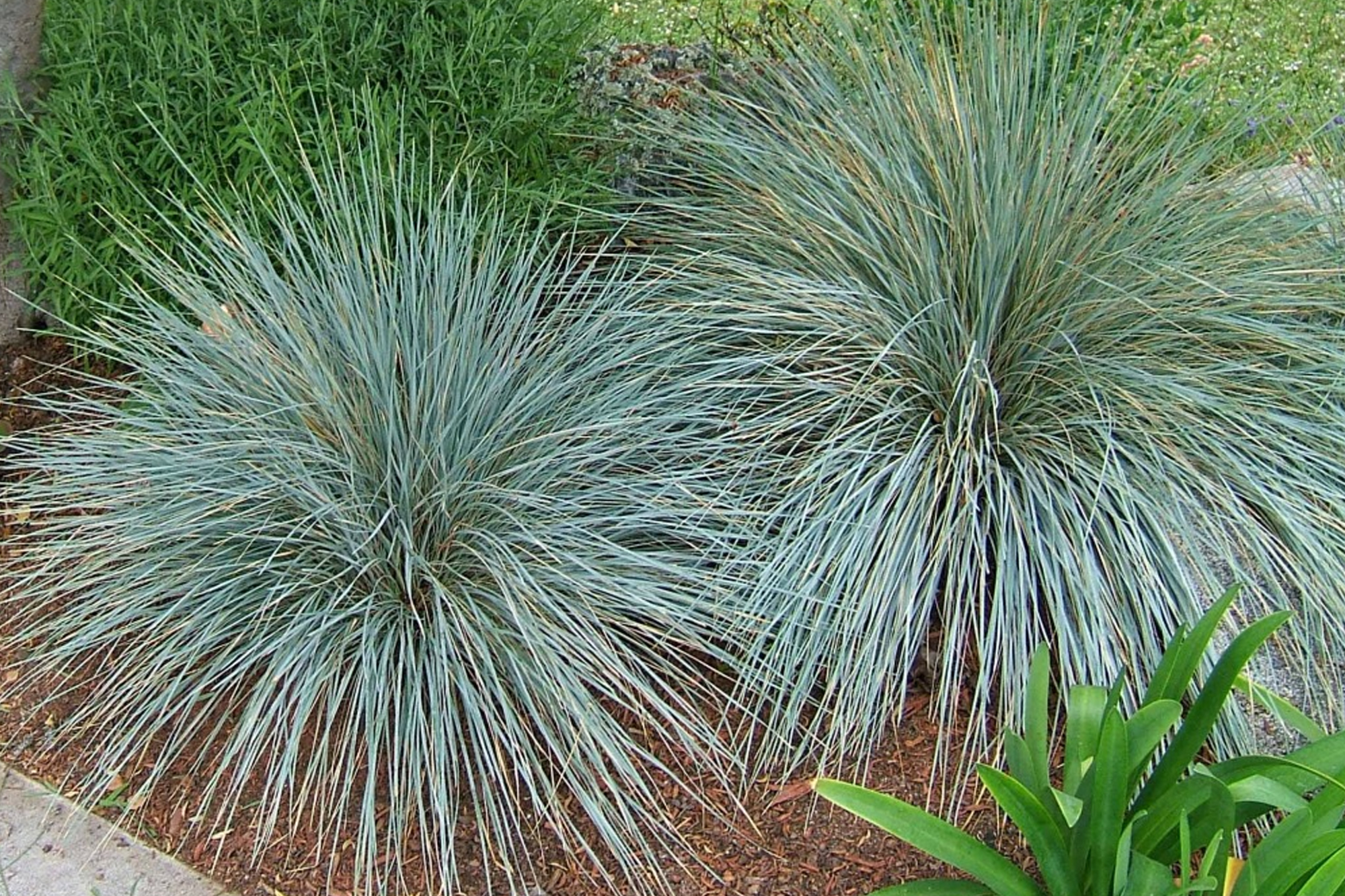
Helictotrichon sempervirens ‘Sapphire’ has deep blue foliage that grows in a rounded clump to a height of 2’. Its graceful stems emerge in late spring and are topped with tan, oat-like seed heads. It prefers full sun and is a great small grass for containers.
Miscanthus
Miscanthus is perhaps the most recognizable group of ornamental grasses. Miscanthus varieties vary in heights, textures and habit but are often recognized by their upright plumes in late summer and autumn. Many varieties can be used to create privacy screens, given their generally tall, dense nature.

^ Miscanthus sinensis ‘Strictus’ is an upright and colorful grass known for horizontal yellow bands on its foliage. In autumn, reddish, fan-shaped seed heads extend above the 7’ tall foliage. It grows in a strongly upright fashion. It makes a beautiful and unique statement in the garden.
Miscanthus sinensis ‘Adagio’ has fine textured, narrow leaves and grows in a compact, rounded shape. Fan-shaped, rose colored flowers rise above the foliage. The leaves turn a beautiful burgundy hue in autumn. At 4’ in height (reaching 5’ with blooms), it is suitable for small spaces, borders and massed plantings.
Miscanthus sinensis ‘Gracillimus’ is known for its elegant form and narrow, silver-veined foliage that grows in a pleasing symmetrical vase shape. Long stems produce fan-like, reddish plumes held high above the leaves. Flowers turn silvery-white as they mature and the foliage becomes auburn-gold after the first frost. It keeps its shape well into the winter. It grows to a height of 6’, reaching 7’ with its flowers.
Miscanthus sinensis ‘Morning Light’ is one of the most popular in its genus with finely textured, slender foliage that has a well-defined white variegation along the leaf margin. It grows in a neat, upright, arching form to a height of 4’, reaching 6’ when in bloom. It is an interesting option for those looking to create a “white garden”. It looks good in a mass planting or standing alone as a specimen.
Miscanthus sinensis ‘Variegatus’ is considered a classic among ornamental grasses. It features beautiful wide leaves with cream-colored stripes running the length of the deep green blades. It grows in an arching shape to 5’ in height and has red-tinted blooms.
Miscanthus sinensis ‘Zebrinus’ is similar to ‘Strictus’ with deep green foliage marked by yellow horizontal bands in random patterns. Some leaves may have more stripes than others. Copper-colored flowers appear at the end of tall stalks. It grows in an arching shape, in contrast to the more erect ‘Strictus’. The foliage of ‘Zebrinus’ will reach a height of 7’ and with its blooms, it will reach 8’.
Muhlenbergia (Pink Muhly grass)
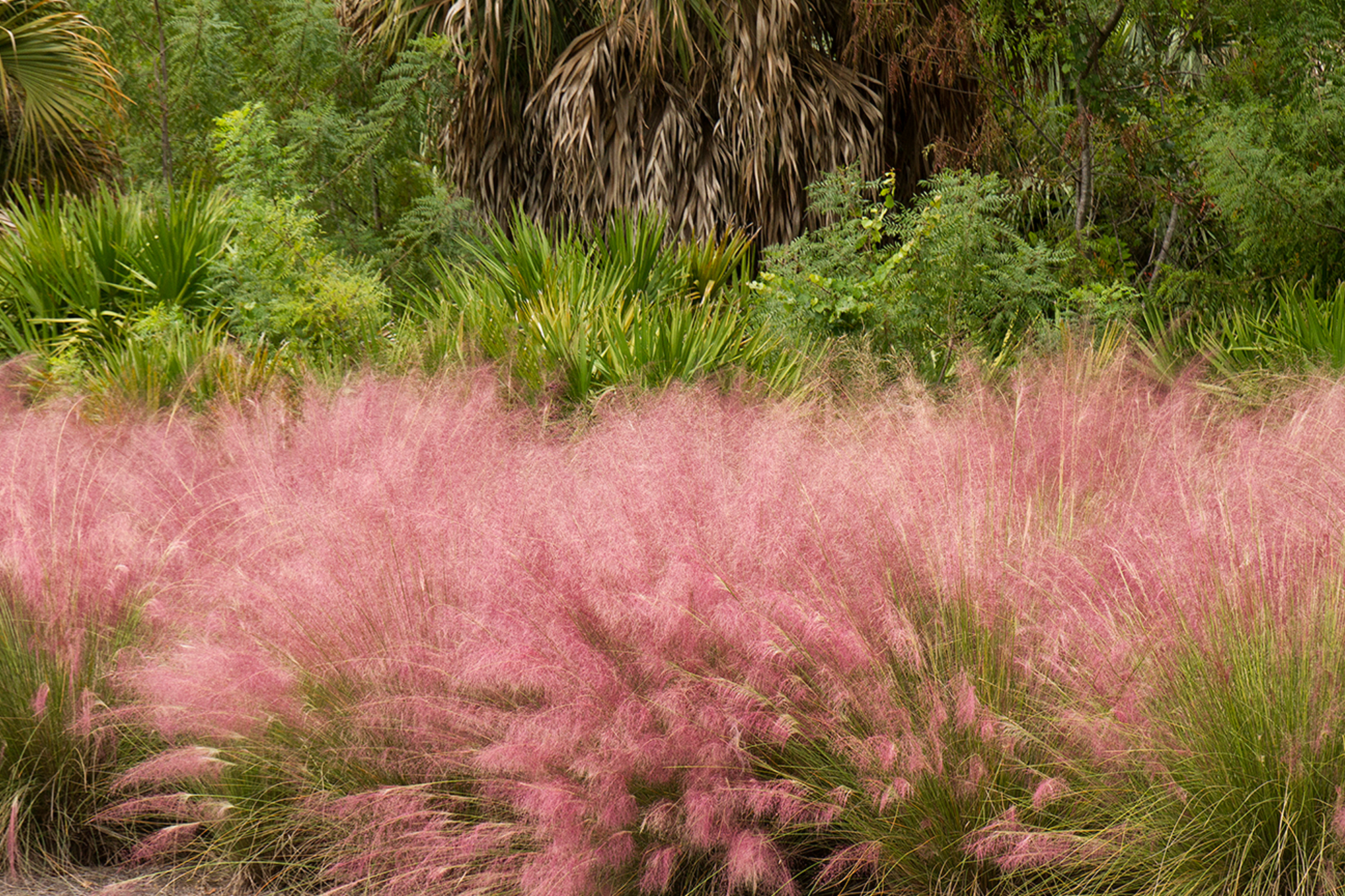
Muhlenbergia capillaris is a North American native. It can stop traffic when in bloom! It grows in a mound of semi-erect, blue-green foliage to a height of 3’. In fall, billowing pink seed heads form a cotton candy crown. It needs full sun and should be planted at least one month before first frost to allow sufficient time to establish.
Panicum (Switchgrass)
Panicum is native to the Prairies of North America. All varieties develop deep, fibrous root systems that help them tolerate poor soil and drought. They have an upright nature that is useful in the garden as a vertical accent to other plantings, or as a screen to enclose an area or hide equipment. Panicum virgatum ‘Dallas Blues’ has wide blue leaves and complementary rose-pink seed heads. It grows to a height of 5’ and adds another foot when in bloom.
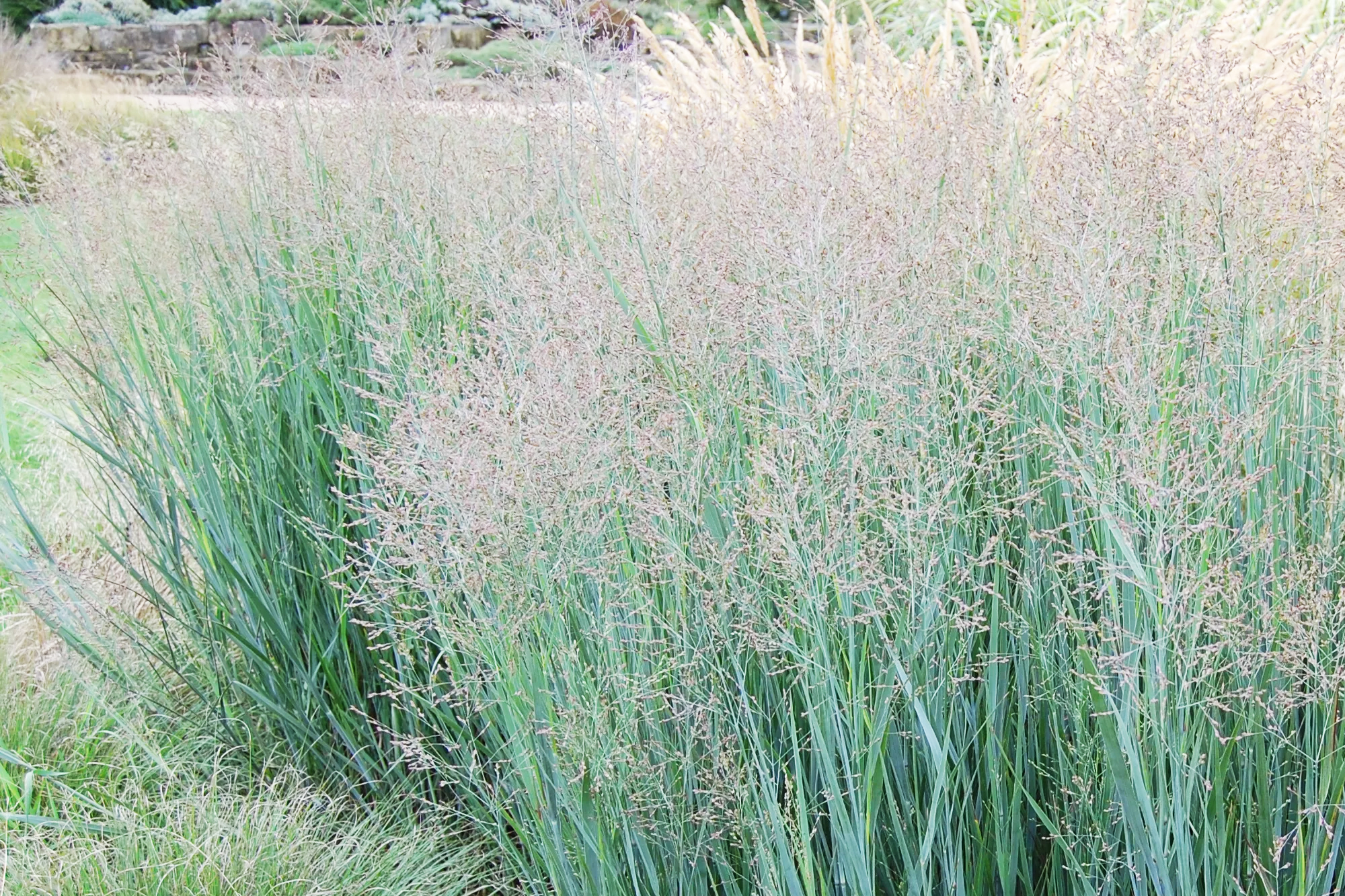
^ Panicum virgatum ‘Heavy Metal’ is appreciated for its metallic-blue foliage, strong upright habit and its pink-tinted, airy midsummer blooms. It can serve as a colorful backdrop, either as a specimen focal point or grouped in a large mass. It grows to a height of 4’, reaching 5’ when in bloom. Panicum virgatum ‘Hot Rod’ emerges blue-green and quickly shifts to deep red. In fall, the foliage becomes deep purple. Topped with red-purple seeds and graced with an upright stature, it is a wonderful and colorful addition to the landscape.
Panicum virgatum ‘Northwind’ has a dependable upright habit and beautiful blue-green foliage. In early fall, it produces a multitude of cream-colored panicles that reach a height of 5-6’. It makes a stunning vertical accent in the garden. When planted in a group, they add a dynamic structural element. In 2014, ‘Northwind’ became the second ornamental grass to be awarded the Perennial Plant of the Year honor.
Panicum virgatum ‘Shenandoah’ is a spectacular red Switchgrass. Its upright foliage becomes red-tinted during the growing season, ending in dazzling red in autumn. It is drought tolerant, easy to maintain, and provides food and shelter for wildlife. Foliage grows to a height of 3’ and the plant reaches 4’ when in bloom.
Pennisetum (Fountain Grass)
Pennisetum grow in a flowing, fountain-like shape and are easily recognized by their bottlebrush plumes. We frequently see varieties with red leaves used in decorative containers and annual beds. While they are not hardy in our winters, there are many varieties, mostly with green foliage, that are strong performers in the New England landscape. They are charming when used as specimen plants and look spectacular when used in sweeping masses.

^Pennisetum alopecuroides ‘Hameln’ is a dwarf variety that grows 2’ tall. It has a lovely fountain-like shape and produces pretty bottlebrush blooms. It is a great edging plant and is also at home in the mixed border.
Pennisetum alopecuroides is a graceful 3’ tall grass with pretty blush-colored bottlebrush plumes that appear in midsummer. The flowers add another foot of height and turn a lovely almond color later in the season. They need full sun and once established, need little care. This grass a very useful in the mixed border and is equally attractive when used in a mass planting.
Even shorter is Pennisetum alopecuroides ‘Little Bunny’ which forms a 1’ by 1’ clump. When planted in a group, they can serve as a ground cover. As with all Pennisetum, they remain attractive well into winter.
Pennisetum alopecuroides ‘Moudry’ forms an upright clump of arching green leaves that reach 2’ tall and 3’ wide. It has bottlebrush spikes of dark purple-black flowers that turn silvery as they dry. The leaves turn bright golden-yellow to orange in the fall.
Pennisetum orientale ‘Karley Rose’ has many great qualities: quick to establish; long-lasting pink plumes; upright, deep-green foliage; drought tolerance; and real hardiness. The foliage grows 2.5’ tall with the same lovely fountain-like shape.
Pennisetum alopecuroides ‘Red Head’ has 8” long red bottlebrush plumes that emerge in midsummer. The foliage is dark green and forms a rounded, arching habit. It is attractive in mixed borders and creates a dramatic wave of color when planted in large groupings.
Schizachyrium scoparium (Little Bluestem)
Schizachyrium scoparium is a North American native. It produces a kaleidoscope of hues in summer that further change color in autumn. It grows in loose clumps that branch out at the top. Summer’s greens, blues and purples turn tones of red and orange in the autumn. Its flowers produce downy, white seeds. The foliage grows to 2’ in height and when in bloom, the plant reaches 3’. Because it develops deep roots and tolerates environments with poor soil, it is useful in covering slopes and in restoration sites. But don’t overlook its potential in the mixed border or in a meadow-inspired landscape.
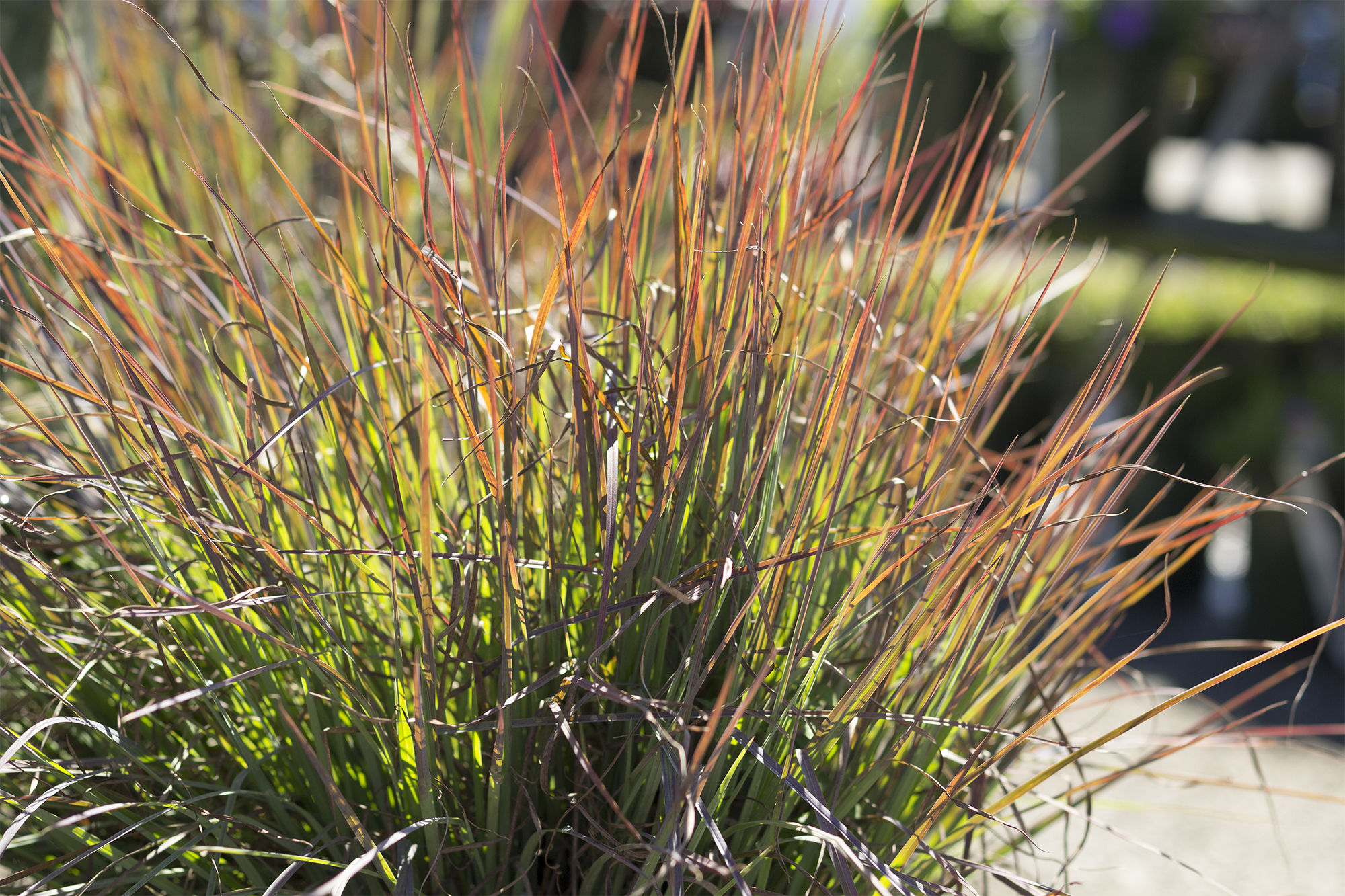
^ Schizachyrium scoparium ‘Standing Ovation’ has an upright quality that results from its sturdy, thick stems. It also has lovely color – blue with hints of greens, purples and pinks that change to shades of red and orange in the autumn. It reaches 3’ in height and adds another foot when in bloom.
